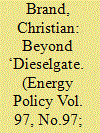| Srl | Item |
| 1 |
ID:
150018


|
|
|
|
|
| Summary/Abstract |
The ‘Dieselgate’ emissions scandal has highlighted long standing concerns that the performance gap between ‘real world’ and'official’ energy use and pollutant emissions of cars is increasing to a level that renders ‘official’ certification ratings virtually ineffective while misleading consumers and damaging human health of the wider population. This paper aims to explore the scale and timing of historic and future impacts on energy use and emissions of the UK car market. To achieve this aim it applies a bespoke disaggregated model of the transport-energy-environment system to explore the impacts of retrospective and future policy scenarios on the UK car market, trade-offs between greenhouse gas and air quality emissions, and fuel use and associated tax revenues. The results suggest that the impacts on human health of ‘real world’ excess NOX emissions in the UK are significant. Future ‘low diesel’ policies can have significant air quality benefits while showing few (if any) carbon disbenefits, suggesting future car pricing incentives may need to be rebalanced taking more account of effects of local air pollution. Car pricing incentives are however unlikely to transform the car market without additional market changes, industry push, infrastructure investment and policy pull aimed at cleaner, lower carbon vehicles.
|
|
|
|
|
|
|
|
|
|
|
|
|
|
|
|
| 2 |
ID:
150025


|
|
|
|
|
| Summary/Abstract |
In the European Union, light duty vehicles (LDVs) are subject to emission targets for carbon dioxide (CO2) and limits for pollutants such as nitrogen oxides (NOx). CO2 emissions are regulated for both passenger vehicles (PV) and light commercial vehicles (LCV), as individual manufacturers are required to reach fleet averages of 130 g/km by 2015 and 175 g/km by 2017, respectively. In the case of PVs, it has been found that there is a significant divergence between real-world and type-approval CO2 emissions, which has been increasing annually, reaching 40% in 2014. On-road exceedances of regulated NOx emission limits for diesel passenger cars have also been documented. The current study investigated the LCV characteristics and CO2 and NOx emissions in the European Union. A vehicle market analysis found that LCVs comprise 17% of the diesel LDV market and while there were some data for CO2 emissions, there were hardly any data publicly available for NOx emissions. Monitoring the divergence in CO2 emissions revealed that it increased from 14% in 2006 to 33% in 2014, posing an additional annual fuel cost from 120€ in 2006 to 305€ in 2014, while a significant percentage of Euro 5 vehicles exceeded NOx emission standards.
|
|
|
|
|
|
|
|
|
|
|
|
|
|
|
|